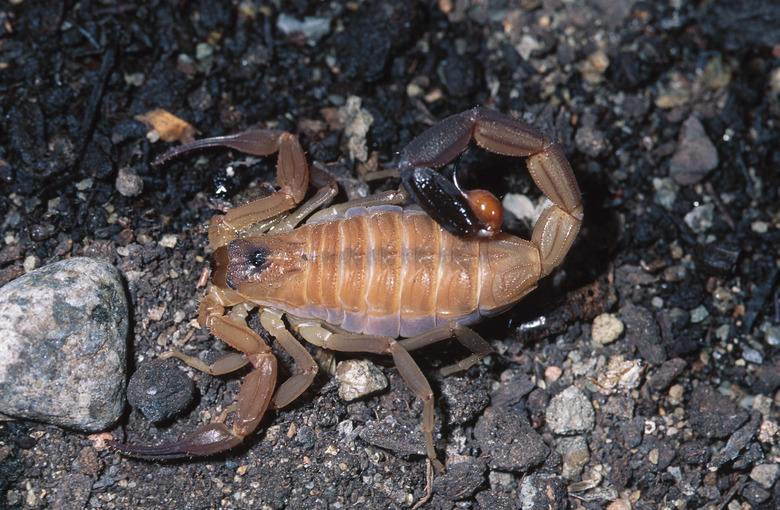Scorpions In Alabama
The two most common Alabama scorpions are the Hentz striped scorpion (Centruroides hentzi) and the southern unstriped scorpion or southern devil scorpion (Vaejovis carolinianus). These two scorpion species prefer living outdoors but occasionally enter homes at night looking for shelter, water or prey. If found indoors, there is no reason for people to fear them as their venom is not lethal to humans or common pets.
Identifying Alabama Scorpions
Identifying Alabama Scorpions
Scorpions are arachnids, so like spiders, they have eight legs. They have a dorso-ventrally flattened body shape, meaning it is the same thickness down the whole body. Next to their eyes are two large pincers. The end of their long tail is bulbous with a stinger at the tip, which they use to capture and eat prey. Within the bulbous end of their tail are a pair of venom-producing glands. Scorpions also use their tail in mating courtships, to help them climb and for defense.
The southern unstriped scorpion has a uniformly dark-grey, dark-brown or blackish body. This type of scorpion grows to be less than two inches long. The Hentz striped scorpion also grows to be around two inches long. It is identifiable by its dark body and three light-brown or yellowish stripes running vertically down the body from the head to the base of the tail.
Alabama Pseudoscorpions
Alabama Pseudoscorpions
Some arachnids look like scorpions but are missing tails. These are aptly named pseudoscorpions of the order Pseudoscorpiones. The Encyclopedia of Alabama identifies 46 species of cave-dwelling pseudoscorpions. Interestingly, pseudoscorpions are actually more closely related to camel spiders of the order Solifugae than to true scorpions of the order Scorpiones.
Alabama Scorpion Ranges
Alabama Scorpion Ranges
One way to tell these common Alabama scorpions apart is by where they are found. The Hentz striped scorpion is found in sandy substrates along the coastal plains of Alabama, Georgia and throughout Florida. The southern unstriped scorpion lives within the mountainous areas of the southern United States, including central and northern Alabama.
Scorpion Life Cycle
Scorpion Life Cycle
During the day, scorpions rest in crevices under rocks, logs, tree bark and woodpiles. At night they hunt other small insects like spiders, centipedes, caterpillars, crickets and occasionally small reptiles, using their pincers and stingers to subdue their prey. While many scorpions live in dry climates, the southern unstriped scorpion prefers humid areas where its prey is abundant. The southern unstriped scorpion is most active in the warmer months from April to June. In the cold winter months, they spend much of their time hiding.
Female scorpions give birth to live young. Before their soft exoskeletons thicken (sometime between ten and 20 days old), baby scorpions cling to their mother's backs and ride along wherever she goes. Once their exoskeletons are harder, they are ready to leave their mother and search for food and shelter independently. After leaving their mother, young scorpions will go through several molts in their first year until they reach full size. The southern unstriped scorpion can live for up to three years.
Alabama Scorpion Stings
Alabama Scorpion Stings
Both of the common Alabama scorpion species have venomous stings that they use to catch prey. They rarely sting humans or pets unless accidentally disturbed when hiding or being handled. Before stinging, the scorpion will raise its pincers and tails in the act of defense.
To avoid disturbing resting scorpions, shake out indoor objects like shoes and sleeping bags before use. Wear gloves when working in the yard or garden and when moving items like piles of dead leaves, firewood and bricks.
For those not allergic to arachnid venom, the stings from Alabama scorpions typically create a sharp pain followed by a burning feeling for around 30 minutes, similar to the effects of a wasp sting. Stings from the southern unstriped scorpion post-winter around March and April may hurt for a longer period and may create a numbing sensation for a couple of hours after the sting.
Cite This Article
MLA
Jerrett, Adrianne. "Scorpions In Alabama" sciencing.com, https://www.sciencing.com/scorpions-alabama-8740139/. 30 September 2021.
APA
Jerrett, Adrianne. (2021, September 30). Scorpions In Alabama. sciencing.com. Retrieved from https://www.sciencing.com/scorpions-alabama-8740139/
Chicago
Jerrett, Adrianne. Scorpions In Alabama last modified March 24, 2022. https://www.sciencing.com/scorpions-alabama-8740139/
